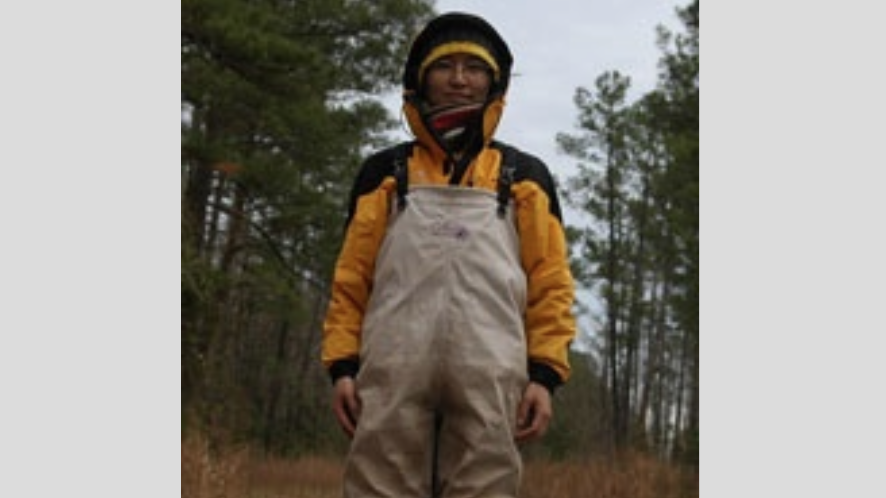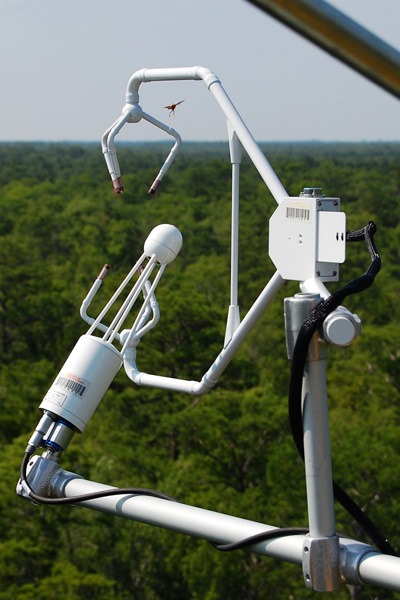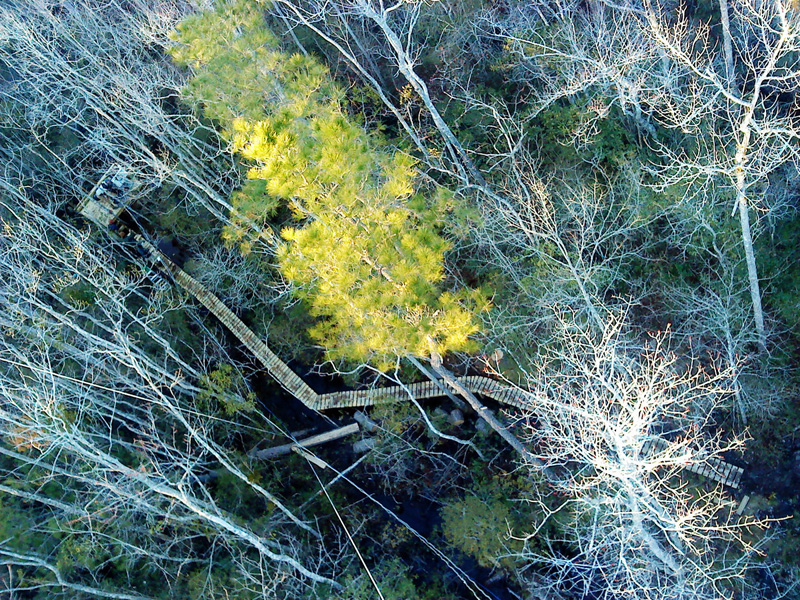Researcher Spotlight – Guofang Miao

PhD student, Department of Forestry and Environmental Resources
Co-advisors: John S. King and Asko Noormets. Dept. of Forestry and Environmental Resources
Every year the Southeast Climate Adaptation Science Center funds a multi-disciplinary cohort of Global Change Fellows representing colleges across NC State University. Here are some highlights about 2012-13 Fellow, Guofang Miao, and the applied research he’s conducting.
 Climate change has been receiving tremendous scientific, political and diplomatic attention during the past few decades. Carbon dioxide (CO2) has been identified as the primary culprit with little ambiguity, and consequently unraveling the myth of the carbon cycle has become an important area of study. To effectively cope with climate change, we need a better understanding of the behavior and interaction of the different anthropogenic and natural carbon sources and sinks. Respiration of terrestrial ecosystems, which releases carbon into the atmosphere and might respond positively to global warming, is a key control of the balance of CO2 exchange between the land surface and atmosphere. Quantification of ecosystem respiration is a challenge, however, because there are many sources of CO2 emissions with varying sensitivity to changes in environmental conditions. Understanding is especially poor for forested wetlands, due to difficulties of quantifying soil processes under flooded conditions. Among various types of terrestrial ecosystems, wetlands store large amounts of carbon in soils (a 2-3% of land surface area stores 18-22% of carbon), but are disproportionately underrepresented in ecosystem carbon cycling studies. Further, forest management that lowers the water table depth as is done for intensive pine silviculture in the US Southeast, may enhance soil respiration, turning ecosystems that usually function to sequester carbon into carbon sources.
Climate change has been receiving tremendous scientific, political and diplomatic attention during the past few decades. Carbon dioxide (CO2) has been identified as the primary culprit with little ambiguity, and consequently unraveling the myth of the carbon cycle has become an important area of study. To effectively cope with climate change, we need a better understanding of the behavior and interaction of the different anthropogenic and natural carbon sources and sinks. Respiration of terrestrial ecosystems, which releases carbon into the atmosphere and might respond positively to global warming, is a key control of the balance of CO2 exchange between the land surface and atmosphere. Quantification of ecosystem respiration is a challenge, however, because there are many sources of CO2 emissions with varying sensitivity to changes in environmental conditions. Understanding is especially poor for forested wetlands, due to difficulties of quantifying soil processes under flooded conditions. Among various types of terrestrial ecosystems, wetlands store large amounts of carbon in soils (a 2-3% of land surface area stores 18-22% of carbon), but are disproportionately underrepresented in ecosystem carbon cycling studies. Further, forest management that lowers the water table depth as is done for intensive pine silviculture in the US Southeast, may enhance soil respiration, turning ecosystems that usually function to sequester carbon into carbon sources.
My PhD project characterizes the respiration processes in a forested wetland in the area between Albemarle Sound and the Pamlico River. This area includes the largest continuous area of wetland in North Carolina and one of the largest in the US. This project aims to identify the mechanisms of carbon cycling by collecting and analyzing data of carbon flux at the soil-plant-atmosphere interface and the associated tree growth, soil characteristics and micro-topography. The monitoring methods and models that we develop for our study are expected to shed light on other wetland ecosystems.  A 40-meter-high observation tower was built to continuously measure CO2 exchange above the forest canopy, and an automated system was mounted on the ground to measure microclimate conditions and CO2 flux from the soil. Additionally, manual measurements are carried out in selected sites within the 1-km2 area around the tower to capture spatial variations. The data that we obtained are of finer temporal and spatial resolutions, with which we are able to improve the models for simulating the respiration processes of wetlands. This also allows us to simulate carbon cycle in this forested wetland with existing ecological models, and ultimately to evaluate its roles in regional carbon cycle under different climate scenarios. The results from this natural wetland will also be compared with the study results from two loblolly pine plantation sites where the water was drained decades ago. This will provide comprehensive knowledge about the ecosystem response to climate change and land use change in this subtropical wetland area.
A 40-meter-high observation tower was built to continuously measure CO2 exchange above the forest canopy, and an automated system was mounted on the ground to measure microclimate conditions and CO2 flux from the soil. Additionally, manual measurements are carried out in selected sites within the 1-km2 area around the tower to capture spatial variations. The data that we obtained are of finer temporal and spatial resolutions, with which we are able to improve the models for simulating the respiration processes of wetlands. This also allows us to simulate carbon cycle in this forested wetland with existing ecological models, and ultimately to evaluate its roles in regional carbon cycle under different climate scenarios. The results from this natural wetland will also be compared with the study results from two loblolly pine plantation sites where the water was drained decades ago. This will provide comprehensive knowledge about the ecosystem response to climate change and land use change in this subtropical wetland area.
Questions
How did you come to study forest ecology?
My background is in chemistry. One of the reasons that ecology attracts me is from reading Aldo Leopold’s book, “A Sand County Almanac”. It taught me another way to see the interactions between nature and human beings. Later I started to learn how to photograph wildflowers, the world of forests became completely different from what I saw before. With the desire of not only seeing the aesthetic beauty of organisms, but also uncovering the mysteries through the scientific method, I chose forest ecology as my PhD major.
What is the most unusual “tool” you use in your research?
 The 40-meter-high observation tower may be the most unusual tool in my research although there are more than 500 study sites in the world using the same technology. The tower is usually called an ‘eddy covariance’ tower, which is the theory used to calculate the CO2 exchange between atmosphere and biosphere. The tower provides the supporter for the automated monitoring system consisting of infrared gas analyzer (for measuring CO2 concentration), 3-dimensional sonic anemometer (for wind speed) and data logger (for recording data continuously). The tower height is determined by the canopy height of forests because all instruments have to be installed above the canopy.
The 40-meter-high observation tower may be the most unusual tool in my research although there are more than 500 study sites in the world using the same technology. The tower is usually called an ‘eddy covariance’ tower, which is the theory used to calculate the CO2 exchange between atmosphere and biosphere. The tower provides the supporter for the automated monitoring system consisting of infrared gas analyzer (for measuring CO2 concentration), 3-dimensional sonic anemometer (for wind speed) and data logger (for recording data continuously). The tower height is determined by the canopy height of forests because all instruments have to be installed above the canopy.
What is the threat of global change that you are most concerned about?
The threat I am most concerned about may be the extreme events resulting from global change, severe drought and severe precipitation events (hurricanes, snow storms and etc.). The extreme events are occurring more frequently, and may cause severe damage to human communities. Nature might evolve against these changes, but the impacts on us are difficult to predict.
Where did you grow up? What was the ecological environment like around you when you were growing up?
I grew up in a small town in China. When I was little, the civilization and industrialization in China had not spread as widely as what is happening today. During holidays, I used to go to the small village where my grandparents lived, hunting fish in the river and frogs in rice paddies. Later I went to universities in Beijing, the capital. The feeling of experiencing the fast change of ecological environment in different cities, from the small one like my home town to the big one like Beijing, is always complicated.
Do you have a species whose fate you are particularly attached to or concerned about?
I do not have a specific species that I am particularly concerned about, but I am truly concerned about the ecological environment in the Qinghai-Tibetan Plateau, one of the most beautiful places where the landscape and culture are both unique. It will be facing the same dilemma between development and conservation of natural resources as many places have been facing in the world.
- Categories:
